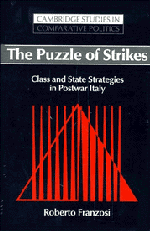Book contents
- Frontmatter
- Contents
- List of tables, figures, and equations
- Dedication
- Preface
- Acknowledgments
- 1 The puzzle box
- 2 Labor-market conditions and bargaining power
- 3 When do workers strike? How the economy matters
- 4 Organizational resources and collective action
- 5 The structure of collective bargaining
- 6 Class power, politics, and conflict
- 7 Mobilization processes: the 1969 autunno caldo
- 8 Countermobilization processes: reactions by the state and employers to strike waves
- 9 The picture in the puzzle
- Epilogue
- Appendix: the data
- Notes
- Bibliography
- Index
Appendix: the data
Published online by Cambridge University Press: 08 January 2010
- Frontmatter
- Contents
- List of tables, figures, and equations
- Dedication
- Preface
- Acknowledgments
- 1 The puzzle box
- 2 Labor-market conditions and bargaining power
- 3 When do workers strike? How the economy matters
- 4 Organizational resources and collective action
- 5 The structure of collective bargaining
- 6 Class power, politics, and conflict
- 7 Mobilization processes: the 1969 autunno caldo
- 8 Countermobilization processes: reactions by the state and employers to strike waves
- 9 The picture in the puzzle
- Epilogue
- Appendix: the data
- Notes
- Bibliography
- Index
Summary
Everything that man says or writes, everything that he makes, everything that he touches can and ought to teach us about him.
Bloch (1953, p. 66)Anything is evidence which is used as evidence … Question and evidence … are correlative. Anything is evidence which enables you to answer your question - the question you are asking now… . nothing is evidence except in relation to some definite question.
Collingwood (1956, pp. 280-1)There is no need to choose between the qualitative and the quantitative evidence: an intelligent rhetoric of economic history would give privilege to neither.
McCloskey (1985, p. 45)In this book I have relied on many different forms of empirical evidence, from quantitative to qualitative. I have used two types of quantitative data: time-series and cross-sectional. Most cross-sectional data came from surveys of workers, union representatives, employers, and firms. Some quantitative data came from content analysis of text sources (e.g. newspapers). Qualitative data came from newspapers, case studies, workers' diaries, oral histories, interviews with workers, union leaders, and employers. I list here at least the main sources in the firm belief that they all provide empirical evidence. More generally, however, I have to admit that I ransacked the library shelves, extensively using books and articles as empirical evidence.
- Type
- Chapter
- Information
- The Puzzle of StrikesClass and State Strategies in Postwar Italy, pp. 379 - 394Publisher: Cambridge University PressPrint publication year: 1995

